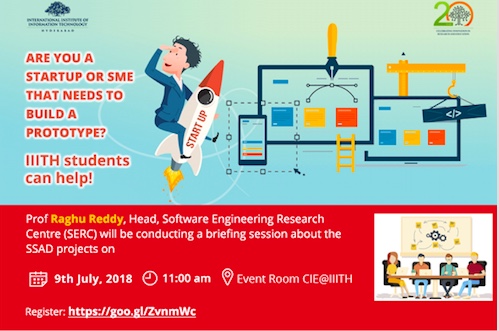Over the years, with its emphasis on applied research, IIIT-H has established various joint collaboration and co-innovation models with an industry outreach spanning significant national and multinational companies. A case in point is the Structured Software Analysis and Design (SSAD) course, offered to Sophomore undergrad students where they work with startups, small and medium-sized businesses. If you are a startup with a project plan looking for help with solutions, or need help in building a prototype, read on.
What is SSAD?
SSAD is a project-oriented course for undergraduate students in their second year that carries 40% weightage of their marks. Students work in teams of 3 or 5 over a 3-month period (spending approximately 7-8 man hours/person/week) to complete a major software development project as part of the course. In the past, students have delivered some impressive projects (some of which are live now) by working with startups, small and medium-sized companies. Prof. Raghu Reddy, head of the Software Engineering Research Centre (SERC) who happens to be the brain behind this course explains it as a core course where students get their first introduction to software engineering. “When we first launched it 7 years ago, students used to work in our own internal research labs, and other make-believe projects. We moved away from that to projects in the real world from real companies outside of IIIT”, he says. Apart from providing them their first exposure to industry, it’s a unique opportunity for the students to apply concepts learnt in class to the real world. Since this is a team-based project, the student is accountable not just to the mentor or the professor but also to the other team members.
Scope and Expectations
Having had an exposure to IT Workshop courses, 2nd year students are fairly familiar with C, Python, web2py, and so on. They are also introduced to software engineering principles and hence expected to produce reasonably good documentation. For startups who have ideas and would like to get software written as part of the work, the students’ inputs could be beneficial. Students are expected to deploy the developed software. While the final scope of the project will be discussed by the team with their project mentor from industry, there are a few guidelines about the nature of the project work itself. This is not the equivalent of an internship and students are NOT required to produce any domain-specific algorithms or ideas. Therefore, any project that may require lot of research (conceptually) will not be suitable. The students are expected to only produce a software layer over existing ideas and algorithms that are already in place. This kind of an industry participation is ideal especially in case of development of a prototype that *may* or *may not* go into the final product, says Prof. Reddy. Echoing his view is Hemanth Satyanarayana, CEO of Imaginate, an AR-VR-Mixed Reality technology enterprise that has pitched projects for this course in the past. “It is a good opportunity to try out your ideas or future roadmap items, but not immediate needs,” he says.
Typically preferred projects are in the areas of mobile app development, web app development or any project that involves reasonably complex software development using database back end, some logic, GUI or network communication.
Role of Project Mentor
The course is expected to have nearly 200 students requiring around 45-50 projects. As a startup or company wishing to propose a project, it is expected that you mentor and evaluate the students who are allocated for your projects. As a mentor, you will be required to spare 3-5 hrs of your time per project mentoring the students on campus. Guidance needs to be only as a customer/end-user — clarifying requirements, suggesting design changes/improvements and giving deadlines. The teams are expected to report to the mentor and the course instructor/TA on a regular basis (weekly/bi-weekly basis). In addition, it will be ideal if the mentor is physically present for the team’s presentation either during Release 1 (approximately Oct 3rdweek) and Release 2 (approximately Nov 2ndweek).
Participating Companies
According to Prof. Raghu Reddy, there has been an increasing number of proposals from various startups and companies on a yearly basis. “Typically the maximum number of project proposals come in from companies incubated by CIE and the T-hub, not in the least due to the ease of physical proximity”, he says. In the past, students have worked with 100+ firms on 250+ projectsfrom companies likeFabulyst, Progress, Accessmachine, Imaginate, Plazyio, SuperGenieTechologies, AppVirality, Ostoryalabs, Polar bear international, AniprTechnologies, RobusTest, iSenseTechnologies, among others.
For more information about the course and the type of projects solicited, Prof. Raghu Reddy will hold a briefing session on 9th July, 11.00 am at CIE Events Room. The course is typically conducted in the Monsoon semester between August and October.
Sarita Chebbi is a compulsive early riser. Devourer of all news. Kettlebell enthusiast. Nit-picker of the written word especially when it’s not her own.


